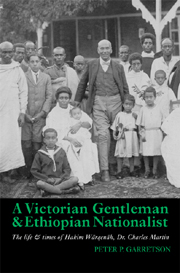 A Victorian Gentleman and Ethiopian Nationalist
A Victorian Gentleman and Ethiopian Nationalist Book contents
- Frontmatter
- Contents
- List of Illustrations
- Transliteration
- Note on the Ethiopian Calendar
- Glossary
- Acknowledgements
- Map 1 Ethiopia 1900–1950
- Map 2 Burma 1898–1919
- Introduction
- 1 Youth & education
- 2 Return to Ethiopia (1896–1901)
- 3 Campaigning in the Ogaden & return to Burma (1901–1907)
- 4 Transitions in life
- 5 A man of substance in Ethiopia & Burma
- 6 Return of a progressive to Addis Ababa (1919–1924)
- 7 An increased pace of modernization (1924–1930)
- 8 International diplomacy, education & recruitment
- 9 Governor of a model province, Chärchär (1930–1935)
- 10 Ethiopian ambassador to the Court of St. James (1935–1936)
- 11 London & India
- 12 Ethiopia
- Conclusion
- Bibliography
- Index
11 - London & India
‘So the whole thing is finished’ (1936–1942)
Published online by Cambridge University Press: 05 April 2013
- Frontmatter
- Contents
- List of Illustrations
- Transliteration
- Note on the Ethiopian Calendar
- Glossary
- Acknowledgements
- Map 1 Ethiopia 1900–1950
- Map 2 Burma 1898–1919
- Introduction
- 1 Youth & education
- 2 Return to Ethiopia (1896–1901)
- 3 Campaigning in the Ogaden & return to Burma (1901–1907)
- 4 Transitions in life
- 5 A man of substance in Ethiopia & Burma
- 6 Return of a progressive to Addis Ababa (1919–1924)
- 7 An increased pace of modernization (1924–1930)
- 8 International diplomacy, education & recruitment
- 9 Governor of a model province, Chärchär (1930–1935)
- 10 Ethiopian ambassador to the Court of St. James (1935–1936)
- 11 London & India
- 12 Ethiopia
- Conclusion
- Bibliography
- Index
Summary
The turning point in Wärqenäh's ambassadorship to Great Britain and in Ethiopia's relationship with Italy came in July 1936. The League of Nations lifted sanctions on Italy, refused to give Ethiopia a loan and the Spanish Civil War began, shifting world attention from Ethiopia to Spain. Ethiopia's global prominence in the newspaper headlines declined significantly and Wärqenäh increasingly lost favor in the emperor's eyes. Wärqenäh still struggled mightily to put Ethiopia's case forward as strongly as he could, but blow after blow hurt her cause on all fronts. The tide only began to turn when Italy declared war on Britain in 1940 and the emperor was transformed from a liability into an asset for the British and their empire. However, by then the emperor and Wärqenäh had become distant and Wärqenäh soon thereafter retired in exile to India. He still defended the Ethiopian cause, putting heart and soul into the effort, but his lifelong belief in the League of Nations and that Britain would in the end do right by Ethiopia had been shaken to the core.
On June 11, 1936 General Graziani replaced Badoglio as the second viceroy of Ethiopia and at the end of June the emperor gave his famous speech at the Assembly of the League of Nations, accusing Italy of using poison gas and illegal means of warfare, attacking the states who had allowed force to win over law and appealing to the small nations of the world and especially Europe who were about to be overwhelmed by the fascist powers.
- Type
- Chapter
- Information
- A Victorian Gentleman and Ethiopian NationalistThe Life and Times of Hakim Wärqenäh, Dr. Charles Martin, pp. 237 - 275Publisher: Boydell & BrewerPrint publication year: 2012
